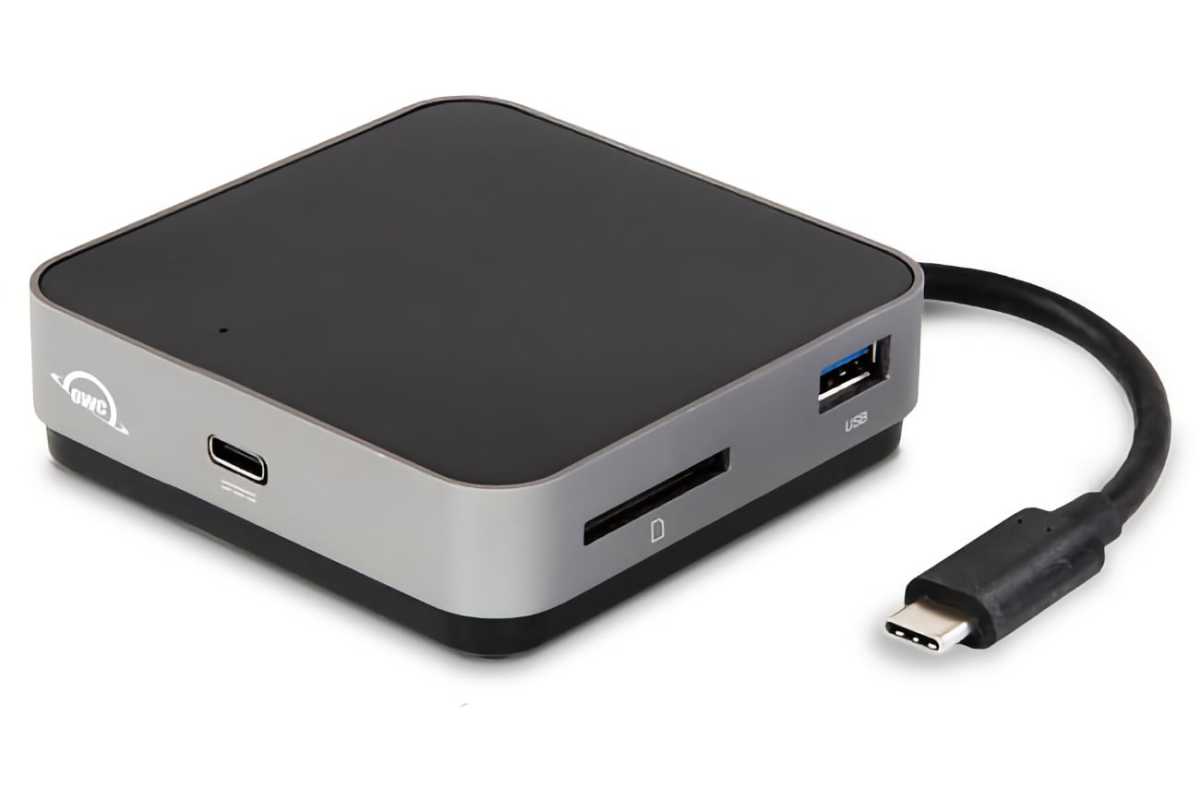The versatile USB-C port allows all sorts of data and power to pass across it. You can attach docks that let you expand your available ports, with spots for USB Type-A, HDMI or DisplayPort video, ethernet, and passthrough power via a USB-C power cable.
But a dock that doesn’t have an external power source—plugged in via an adapter to an AC outlet or through USB-C power pass-through—has strict limits on the power it can draw from a Mac and allot to connected drives and other peripherals. (USB-powered fans and tea warmers, perhaps.)
You can find an excellent explanation of this on the product page for Other World Computing’s USB-C Travel Dock ($54.99). This compact dock has two USB Type-A (3.1 Gen 1) ports, pass-through USB-C power (up to 100 watts), HDMI (4K up to 30Hz), and an SD Card slot (UHS-II).
You can piece together some limits if you dig into the dock’s tech specs and footnotes. When there’s no USB-C power adapter plugged into its pass-through USB-C port, it can draw up 15W from the host Mac, consumes 1.5W for itself, and divvies up the rest between the two Type-A ports, the SD card slot, and the HDMI port. Those latter two purposes don’t require much, but it can matter with just 12W to play with.
When plugged into a USB-C power adapter, however, the dock can reserve up to 25.5W from up to 100W of power delivered through the adapter: 1.5W for itself and up to 12W for each of the Type-A ports. The remainder is passed through to charge the computer.
An external USB 3.0 or later SSD or hard disk drive has to work within a peak power budget of about 4W. The maximum they can expect to draw from a standard port is 4.5W (5 volts at 900 milliamps), the minimum port spec for USB 3. Staying at 4W or below avoids getting too close to the maximum and causing the port to shut down. (CD/DVD drives and bus-powered peripherals skirt the line and may cross it. As a result, they often come equipped with two USB plugs—I had a Fujitsu scanner that took that approach—or an AC adapter to run the disc’s laser or other power-hungry elements.)
 https://b2c-contenthub.com/wp-content/uploads/2022/02/owc-usbc-travel-dock.jpg?resize=300%2C200&quality=50&strip=all 300w, https://b2c-contenthub.com/wp-content/uploads/2022/02/owc-usbc-travel-dock.jpg?resize=768%2C512&quality=50&strip=all 768w, https://b2c-contenthub.com/wp-content/uploads/2022/02/owc-usbc-travel-dock.jpg?resize=1200%2C800&quality=50&strip=all 1200w, https://b2c-contenthub.com/wp-content/uploads/2022/02/owc-usbc-travel-dock.jpg?resize=1240%2C826&quality=50&strip=all 1240w, https://b2c-contenthub.com/wp-content/uploads/2022/02/owc-usbc-travel-dock.jpg?resize=150%2C100&quality=50&strip=all 150w" width="1200" height="800" sizes="(max-width: 1200px) 100vw, 1200px" />
https://b2c-contenthub.com/wp-content/uploads/2022/02/owc-usbc-travel-dock.jpg?resize=300%2C200&quality=50&strip=all 300w, https://b2c-contenthub.com/wp-content/uploads/2022/02/owc-usbc-travel-dock.jpg?resize=768%2C512&quality=50&strip=all 768w, https://b2c-contenthub.com/wp-content/uploads/2022/02/owc-usbc-travel-dock.jpg?resize=1200%2C800&quality=50&strip=all 1200w, https://b2c-contenthub.com/wp-content/uploads/2022/02/owc-usbc-travel-dock.jpg?resize=1240%2C826&quality=50&strip=all 1240w, https://b2c-contenthub.com/wp-content/uploads/2022/02/owc-usbc-travel-dock.jpg?resize=150%2C100&quality=50&strip=all 150w" width="1200" height="800" sizes="(max-width: 1200px) 100vw, 1200px" />When it’s not using a power adapter, the OWC’s USB-C Travel Dock can draw up 15W from the host Mac.
OWC
When connected directly to a computer, a drive can almost always pull that power continuously, just like you can plug in a mobile device and charge at up to 5W over a period of time. A mobile device doesn’t mind if the power sags, but an external drive’s controller will crash or turn off, resulting in an involuntarily unmounted volume. You might lose data or have to run Disk Utility to repair it.
With a dock that manages bus power among multiple devices, you can run afoul of the bus-powered maximums. Suppose you’re using the OWC dock above and you’ve got an external monitor attached, an SD card inserted, and a hard drive connected plugged into one port, and have a USB charging cable for your iPhone plugged into the other—well, that could be right below 12W. Any hiccup or millisecond power-balancing issue, and the SD card and drive get knocked offline briefly.
Check the numbers
My advice should make you wary of any dock that doesn’t offers wattage numbers in its technical specifications. One reader sent us a message about an issue with a drive consistently disconnecting with a particular dock—one I also happen to own and have seen similar power issues with. (I don’t want to call out the company since this isn’t a review.)
When you consult the product page for this dock, the company doesn’t list its maximum output, nor does it call out any port limitations—save one. It says that you can’t attach an external CD/DVD reader (including Apple’s old SuperDrive, a blast from the past) because the dock can’t deliver these peripherals’ peak power needs.
But it makes me wonder if they skimped on the overall power availability, making the dock substantially less useful without customers realizing it.
Thunderbolt 3 and 4 docks don’t seem to have the same problem as USB 3-only USB-C docks because bus-powered Thunderbolt docks seem quite rare—I’ve only found a few minimally featured Thunderbolt 3 docks of that kind. The higher power demands of Thunderbolt docks typically need wattage above what can be delivered from a USB-C port on a Mac laptop or desktop. The docks either require a high-wattage USB-C cable connected to an adapter or include an AC power adapter.
This Mac 911 article is in response to a question submitted by Macworld reader Greg.
Ask Mac 911
We’ve compiled a list of the questions we get asked most frequently, along with answers and links to columns: read our super FAQ to see if your question is covered. If not, we’re always looking for new problems to solve! Email yours to mac911@macworld.com, including screen captures as appropriate and whether you want your full name used. Not every question will be answered, we don’t reply to email, and we cannot provide direct troubleshooting advice.





